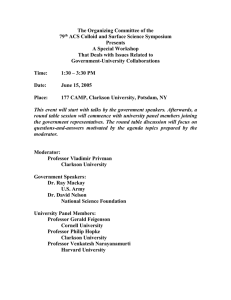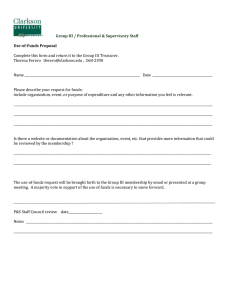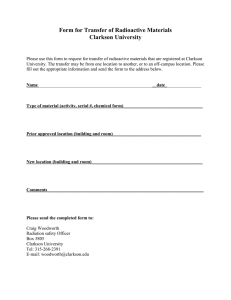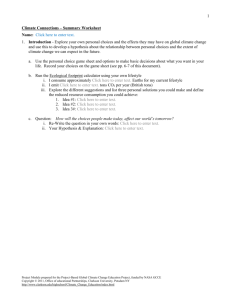1
advertisement
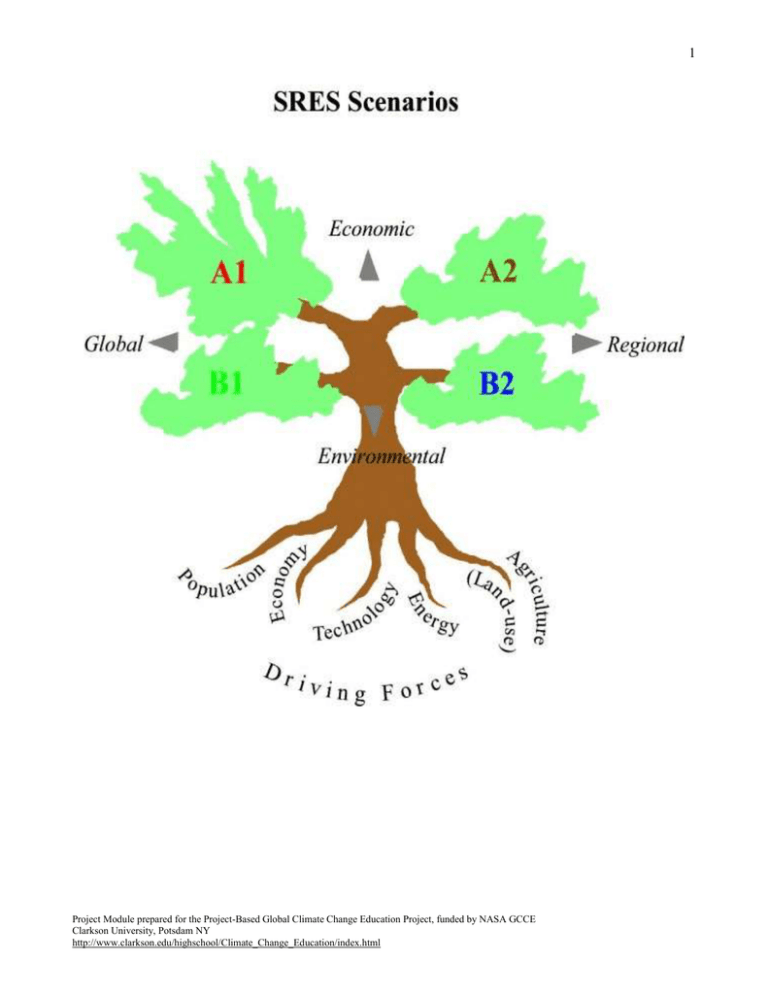
1 Project Module prepared for the Project-Based Global Climate Change Education Project, funded by NASA GCCE Clarkson University, Potsdam NY http://www.clarkson.edu/highschool/Climate_Change_Education/index.html 2 PERSONAL CHOICE POINTS SHEET Home Points Auto/Vehicle Points Trailer or smaller. 1 Walk/Bicycle/ Public Transportation 0 Apartment 2 Hybrid- Toyota Prius 2 Medium sized house. 3 Full size pick- up truck 3 Mansion 5,000 sq.ft. 4 luxury SUV 4 Entertainment Points Clothing Points Board games 1 Thrift store 0 Large Screen TV 2 Fair Trade/Union Made 2 Hot tub 3 MegaMart/Mall 3 Jet ski and 4-wheeler 4 Gucci/ Brooks Brothers 4 Food Points Vacation Points Self Sufficient 0 None 0 Fair trade / Locally grown 1 Camping 1 Industrial Agribusiness 3 Cheap international trips 3 Premium and Expensive 4 Disney World 4 Environmental Laws & Regulations Points International cooperation and monitoring 1 Regional air and water pollution regs. 2 Limited regulation for regional economy development 3 No regulations 4 Use these values to fill in points on the Personal Choice Game Sheet Project Module prepared for the Project-Based Global Climate Change Education Project, funded by NASA GCCE Clarkson University, Potsdam NY http://www.clarkson.edu/highschool/Climate_Change_Education/index.html 3 SRES Scenarios Summary: Total Points Scenario Characteristics ≥25 Global, Economically Oriented – Fossil intensive (A1 FI) Population growth and decline Technological advances applied globally – bias towards further development of fossil fuels Equity in economic development among regions 19-24 10-18 <10 Statistics for 2100 o 7 billion population o $550 trillion GDP o HIGH emissions scenario Regional, Economically oriented (A2) Population growth Differences among regions - Technological advances, resource consumption and culture o 15 billion population o $250 trillion GDP o HIGH emissions scenario Regional, Environmentally oriented (B2) local solutions to economic, social, and environmental sustainability economic equity within regions, but not between regions less rapid and more diverse technological changes global policies for climate change mitigation o 10 billion population, o $250 trillion GDP o MEDIUM emissions scenario Global, Environmentally oriented (B1) global solutions to economic, social, and environmental sustainability no additional climate initiatives service and information oriented economy reductions in material intensity clean and resource-efficient technologies o 7 billion population o $350 trillion GDP o LOW emissions scenario Project Module prepared for the Project-Based Global Climate Change Education Project, funded by NASA GCCE Clarkson University, Potsdam NY http://www.clarkson.edu/highschool/Climate_Change_Education/index.html 4 SRES Scenarios Detailed: Global, Economic Oriented Storyline The Global, Economic Growth storyline is a case of rapid and successful global economic development, in which current distinctions between "poor" and "rich" countries eventually dissolve. The transition to economic convergence results from advances in transport and communication technology shifts in national policies on immigration and education, and international cooperation in the development of national and international institutions that enhance productivity growth and technology diffusion. High level of affluence that is correlated with long life and small families (low mortality and low fertility). Global population grows to some nine billion by 2050 and declines to about seven billion by 2100. Energy and mineral resources are abundant. Rapid technical progress, which both reduces the resources needed to produce a given level of output and increases the economically recoverable reserves. The concept of environmental quality changes from "conservation" of nature to active "management" of natural and environmental services, which increases ecologic resilience. Increased consumption of meat and dairy products, but concurrent with increasing emphasis on the health of an aging society. High car ownership, sprawling suburbia, and dense transport networks, nationally and internationally. Uncertainty in the development of energy sources and conversion technologies in this rapidly changing world. Project Module prepared for the Project-Based Global Climate Change Education Project, funded by NASA GCCE Clarkson University, Potsdam NY http://www.clarkson.edu/highschool/Climate_Change_Education/index.html 5 Regional, Economic Growth Storyline The Regional, Economic Growth Storyline scenario represents a world where the developed and developing regions continue to have significant disparities. This scenario family represents a differentiated world. Compared to the Global, Economic Growth storyline it is characterized by lower trade flows, relatively slow capital stock turnover, and slower technological change. This world "consolidates" into a series of economic regions. Selfreliance in terms of resources and less emphasis on economic, social, and cultural interactions between regions are characteristic for this future. Economic growth is uneven and the income gap between now-industrialized and developing parts of the world does not narrow. Less international cooperation leading to less trade flows and slower technological change in some regions. Economic growth is uneven and the income gap between now-industrialized and developing parts of the world continues. Self-reliance in terms of resources. Less emphasis on economic, social, and cultural interactions between regions. The fuel mix in different regions is determined primarily by resource availability. Agricultural productivity is one of the main focal points for innovation and research efforts. Environmental concerns lead to local development of more sustainable highyield agriculture. Emphasis is on family and community life, fertility rates decline relatively slowly, which makes the Regional, Economic Growth Storyline population the largest among the storylines (15 billion by 2100). Attempts are made to bring regional and local pollution under control and to maintain environmental amenities. Project Module prepared for the Project-Based Global Climate Change Education Project, funded by NASA GCCE Clarkson University, Potsdam NY http://www.clarkson.edu/highschool/Climate_Change_Education/index.html 6 Global, Environmentally Oriented Storyline The future in the Global, Environmentally Oriented Storyline scenario includes a high level of environmental and social consciousness combined with a globally coherent approach to a more sustainable development. Governments, businesses, the media, and the public pay increased attention to the environmental and social aspects of development. Technological change plays an important role. However, specific climate related policies are not included. Even without climate policies, this scenario results in the lowest GHG emissions among all of the scenarios. Some key features of this scenario include: High levels of economic activity (a global GDP of around US$350 trillion by 2100) and significant and deliberate progress toward international and national income equality. Economic investments towards gains in improved efficiency of resource use ("dematerialization"), equity, social institutions, and environmental protection. Resource consumption is limited by increased environmental taxation. Global diffusion of cleaner technology. Low mortality and fertility - global population reaches nine billion by 2050 and declines to about seven billion by 2100. Income is spent on services rather than on material goods, and on quality rather than quantity. Smooth transition to alternative energy systems as conventional oil and gas resources decline. Significant government controls, regulation and land use management Project Module prepared for the Project-Based Global Climate Change Education Project, funded by NASA GCCE Clarkson University, Potsdam NY http://www.clarkson.edu/highschool/Climate_Change_Education/index.html 7 Regional, Environmentally Oriented Storyline The Regional, Environmentally Oriented Storyline world is one of increased concern for environmental and social sustainability when compared to the Regional, Economic Growth storyline. Increasingly, government policies and business strategies at the national and local levels are influenced by environmentally aware citizens, with a trend toward local self-reliance and stronger communities. Decision-making structures and institutions are predominantly at the local and regional levels. Some key features include: Education and welfare programs are pursued widely, which reduces mortality and, to a lesser extent, fertility. The population reaches about 10 billion people by 2100. International income differences decrease, although not as rapidly as in storylines of higher globalization. Local inequity is reduced considerably through the development of stronger community-support networks. High educational levels promote both development and environmental protection. Favorable climate for community initiative and social innovation. Technical innovations differ among the regions. Land-use management becomes better integrated at the local level. Urban and transport infrastructure is a particular focus of community innovation - less urban sprawl. Emphasis on food self-reliance, with relatively low meat consumption in countries with high population densities. Energy systems differ from region to region, depending on the availability of natural resources, although globally the energy system remains predominantly hydrocarbonbased to 2100. Environment policy cooperation at the regional level leads to success in the management of some transboundary environmental problems. Resources: IPCC, 2000. Special Report on Emissions Scenarios, N. Nakicenovic and R. Swart (Eds.), http://www.ipcc.ch/ipccreports/sres/emission/index.php?idp=0 Cambridge University Press, UK. pp 570. Project Module prepared for the Project-Based Global Climate Change Education Project, funded by NASA GCCE Clarkson University, Potsdam NY http://www.clarkson.edu/highschool/Climate_Change_Education/index.html
